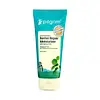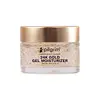What's inside
What's inside
 Key Ingredients
Key Ingredients

 Benefits
Benefits

 Concerns
Concerns

 Ingredients Side-by-side
Ingredients Side-by-side

Water
Skin ConditioningCaprylic/Capric Triglyceride
MaskingDimethicone
EmollientNiacinamide
SmoothingGlycerin
HumectantPropanediol
SolventCetyl Alcohol
EmollientSodium Acrylates Copolymer
Lecithin
EmollientPrunus Amygdalus Dulcis Oil
Skin ConditioningLaminaria Digitata Extract
Skin ProtectingCetyl-Pg Hydroxyethyl Palmitamide
Skin ConditioningCeramide EOP
Skin ConditioningCeramide Ns
Skin ConditioningCeramide NP
Skin ConditioningCeramide As
Skin ConditioningCeramide AP
Skin ConditioningDextran
Tripeptide-1
Skin ConditioningOryza Sativa Extract
AbsorbentLactococcus Ferment Lysate
Skin ConditioningCentella Asiatica Extract
CleansingSodium Hyaluronate
HumectantHydrogenated Polydecene
EmollientPPG-1 Trideceth-6
Skin ConditioningStearic Acid
CleansingCetearyl Olivate
Sorbitan Olivate
EmulsifyingCarbomer
Emulsion StabilisingPhenoxyethanol
PreservativeEthylhexylglycerin
Skin ConditioningBetaine
HumectantSodium Benzoate
MaskingPotassium Sorbate
PreservativeTocopheryl Acetate
AntioxidantSodium Hydroxide
BufferingSodium Gluconate
Skin ConditioningWater, Caprylic/Capric Triglyceride, Dimethicone, Niacinamide, Glycerin, Propanediol, Cetyl Alcohol, Sodium Acrylates Copolymer, Lecithin, Prunus Amygdalus Dulcis Oil, Laminaria Digitata Extract, Cetyl-Pg Hydroxyethyl Palmitamide, Ceramide EOP, Ceramide Ns, Ceramide NP, Ceramide As, Ceramide AP, Dextran, Tripeptide-1, Oryza Sativa Extract, Lactococcus Ferment Lysate, Centella Asiatica Extract, Sodium Hyaluronate, Hydrogenated Polydecene, PPG-1 Trideceth-6, Stearic Acid, Cetearyl Olivate, Sorbitan Olivate, Carbomer, Phenoxyethanol, Ethylhexylglycerin, Betaine, Sodium Benzoate, Potassium Sorbate, Tocopheryl Acetate, Sodium Hydroxide, Sodium Gluconate
Water
Skin ConditioningPropanediol
SolventNiacinamide
SmoothingButylene Glycol
HumectantPentylene Glycol
Skin ConditioningBetaine
HumectantGlycyrrhiza Glabra Root Extract
BleachingMorus Alba Extract
AstringentNelumbo Nucifera Flower Extract
Skin ConditioningNymphaea Alba Flower Extract
Skin ConditioningAlpha-Arbutin
AntioxidantPhenoxyethanol
PreservativeEthylhexylglycerin
Skin ConditioningAcrylates/C10-30 Alkyl Acrylate Crosspolymer
Emulsion StabilisingOlive Oil PEG-7 Esters
EmollientSodium PCA
HumectantSodium Lactate
BufferingSodium Gluconate
Skin ConditioningXylitylglucoside
HumectantAnhydroxylitol
HumectantXylitol
HumectantSodium Hyaluronate
HumectantPEG-40 Hydrogenated Castor Oil
EmulsifyingHeptyl Glucoside
Allantoin
Skin ConditioningGold
Cosmetic ColorantParfum
MaskingWater, Propanediol, Niacinamide, Butylene Glycol, Pentylene Glycol, Betaine, Glycyrrhiza Glabra Root Extract, Morus Alba Extract, Nelumbo Nucifera Flower Extract, Nymphaea Alba Flower Extract, Alpha-Arbutin, Phenoxyethanol, Ethylhexylglycerin, Acrylates/C10-30 Alkyl Acrylate Crosspolymer, Olive Oil PEG-7 Esters, Sodium PCA, Sodium Lactate, Sodium Gluconate, Xylitylglucoside, Anhydroxylitol, Xylitol, Sodium Hyaluronate, PEG-40 Hydrogenated Castor Oil, Heptyl Glucoside, Allantoin, Gold, Parfum
Ingredients Explained
These ingredients are found in both products.
Ingredients higher up in an ingredient list are typically present in a larger amount.
Betaine is a common humectant (a substance that promotes retention of moisture). It's known to be gentle on the skin and can help balance hydration.
This ingredient is best for improving hydration and soothing irritated skin. Studies also show it helps even out skin tone.
Fun fact: Betaine is naturally created in the skin and body. The kind found within cosmetic products can be either plant-derived or synthetic.
Another name for betaine is trimethylglycine.
Learn more about BetaineEthylhexylglycerin (we can't pronounce this either) is commonly used as a preservative and skin softener. It is derived from glyceryl.
You might see Ethylhexylglycerin often paired with other preservatives such as phenoxyethanol. Ethylhexylglycerin has been found to increase the effectiveness of these other preservatives.
Niacinamide is a multitasking form of vitamin B3 that strengthens the skin barrier, reduces pores and dark spots, regulates oil, and improves signs of aging.
And the best part? It's gentle and well-tolerated by most skin types, including sensitive and reactive skin.
You might have heard of "niacin flush", or the reddening of skin that causes itchiness. Niacinamide has not been found to cause this.
In very rare cases, some individuals may not be able to tolerate niacinamide at all or experience an allergic reaction to it.
If you are experiencing flaking, irritation, and dryness with this ingredient, be sure to double check all your products as this ingredient can be found in all categories of skincare.
When incorporating niacinamide into your routine, look out for concentration amounts. Typically, 5% niacinamide provides benefits such as fading dark spots. However, if you have sensitive skin, it is better to begin with a smaller concentration.
When you apply niacinamide to your skin, your body converts it into nicotinamide adenine dinucleotide (NAD). NAD is an essential coenzyme that is already found in your cells as "fuel" and powers countless biological processes.
In your skin, NAD helps repair cell damage, produce new healthy cells, support collagen production, strengthen the skin barrier, and fight environmental stressors (like UV and pollution).
Our natural NAD levels start to decline with age, leading to slower skin repair, visible aging, and a weaker skin barrier. By providing your skin niacinamide, you're recharging your skin's NAD levels. This leads to stronger, healthier, and younger looking skin.
Another name for vitamin B3 is nicotinamide. This vitamin is water-soluble and our bodies don't store it. We obtain Vitamin B3 from either food or skincare. Meat, fish, wheat, yeast, and leafy greens contain vitamin B3.
The type of niacinamide used in skincare is synthetically created.
Learn more about NiacinamidePhenoxyethanol is a preservative that has germicide, antimicrobial, and aromatic properties. Studies show that phenoxyethanol can prevent microbial growth. By itself, it has a scent that is similar to that of a rose.
It's often used in formulations along with Caprylyl Glycol to preserve the shelf life of products.
Propanediol is an all-star ingredient. It softens, hydrates, and smooths the skin.
It’s often used to:
Propanediol is not likely to cause sensitivity and considered safe to use. It is derived from corn or petroleum with a clear color and no scent.
Learn more about PropanediolThis is the synthetic salt of gluconic acid, a form of PHA and mild exfoliant.
It is mainly used to stabilize oil and butter formulations from going bad. Sodium gluconate is a humectant, pH regulator, and chelating agent.
Chelating agents help neutralize unwanted metals from affecting the formulation.
Sodium gluconate is water-soluble.
Learn more about Sodium GluconateSodium Hyaluronate is hyaluronic acid's salt form. It is commonly derived from the sodium salt of hyaluronic acid.
Like hyaluronic acid, it is great at holding water and acts as a humectant. This makes it a great skin hydrating ingredient.
Sodium Hyaluronate is naturally occurring in our bodies and is mostly found in eye fluid and joints.
These are some other common types of Hyaluronic Acid:
Learn more about Sodium HyaluronateWater. It's the most common cosmetic ingredient of all. You'll usually see it at the top of ingredient lists, meaning that it makes up the largest part of the product.
So why is it so popular? Water most often acts as a solvent - this means that it helps dissolve other ingredients into the formulation.
You'll also recognize water as that liquid we all need to stay alive. If you see this, drink a glass of water. Stay hydrated!
Learn more about Water